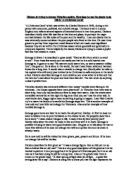How does Dickens use Scrooge to highlight injustice in Victorian society?
A Christmas Carol which is a bildungsroman written by Charles Dickens in the 1800’s, an undermining social diatribe possibly accusing the political injustice. As a Unitarian he was passionate about morality and ethics and abhorred the poverty inflicted on the underclass by the obnoxious upper-class. The poor were merely pledged to a life working for little pay often in the Debtor’s prisons enacted by the Poor Laws. Dickens critiques this through the use of Scrooge the protagonist of the novella whom undergoes a transformative change which shows the effects on himself and those around him. He begins as an allegory for the exploitive parsimonious upper-class, exemplified as being a money lender. Dickens, who passionately believes in a full humanity uses the theme of injustice symbiotically with redemption to unify all classes in a more civilised and utopian idealistic society. His reformation is aided by the three ghosts, who show him his past present and future and how his actions have influenced others.
In the exposition Scrooge is introduced as a ‘squeezing, wrenching, grasping, scraping, clutching, covetous old sinner’, and this lexis of constricting verbs suggest his violent and manic pursuit for money, which shows his greed and materialistic needs as he ‘clutches’ out of desperation. The phrase ‘solitary as an oyster’ could connote to several things. Firstly, an ‘oyster’ is a calcified shell that is extremely difficult to open, likewise, Scrooge is very emotionally difficult to converse with. This could refer to his oblivious attitude to the poor, and be the reason the rich upper-class dismiss the lower class. However, in time, the ‘oyster’ opens to reveal a pearl. This could implicitly infer that with force, he could become a better person. This imagery is used to show how Scrooge has become metaphorically emotionally frozen because of his actions and isolation. ‘External heat and cold had little influence on Scrooge’ shows that the bad weather (or his negativity) is coming from him which is why it doesn’t affect him. The use of ‘misanthropic ice’ later in the stave enforces the idea that his wealth and disregard for others and humanity to find wealth is what has led to his frozen emotions ‘misanthropic’ could have been used to show his hatred for humanity but also his disliking for the poor because of their lack of wealth. This was a common opinion at the time when workhouses and debtors prisons were common and were funded indirectly by the wealthy middle class industrialists and so Scrooge could believe that this action justifies his lack of generosity and humanity to the poor.








